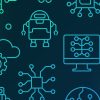In recent years, manufacturing has changed a lot, especially with tools like generative AI stepping into the spotlight. Today’s production lines, full of conveyors and robots, look nothing like the oil-stained factories of the past. Generative AI is just one of the many new technologies reshaping how things are made.
Here are eight ways manufacturers are using generative AI today:
-
Product Design and Optimization
Generative AI speeds up product design by quickly generating various design options based on specific goals and constraints. Engineers input parameters like materials, costs, and strength requirements. While human designers often stick to what they know, AI can suggest a wider range of designs. But manufacturers need to stay updated on the latest AI-related regulations and ensure that all AI-generated designs meet safety and compliance standards. Engineers still play a crucial role in refining these AI outputs to make them practical. -
Quality Control and Defect Detection
In quality assurance, generative AI enhances defect detection, often catching issues earlier and more reliably than traditional methods. Engineers train AI models with data from both good and defective products, enabling the system to identify various flaws. On the production line, computer vision can pinpoint tiny defects, like hairline cracks, that a human might overlook. -
Predictive Maintenance and Equipment Monitoring
Generative AI can also assist with predictive maintenance. Machines send real-time data on vibrations, temperature, pressure, and noise. Subtle changes in these readings might hint at potential problems, which traditional systems might miss. Operators can then schedule maintenance proactively, much like a mechanic who checks a vehicle’s sensor data to prevent future issues. -
Supply Chain Optimization and Demand Forecasting
Generative AI improves supply chain management, refining demand forecasts and logistics. By analyzing large data sets—historical sales, market trends, and weather patterns—AI predicts product demand more accurately. Manufacturers can use this data to optimize inventory levels and streamline delivery routes, adjusting for real-time traffic or unforeseen disruptions. -
Process Automation and Efficiency Improvement
Digital twins are an exciting application of generative AI. These virtual simulations of manufacturing processes allow companies to monitor operations in real-time. By feeding data into these systems, manufacturers can find the best production plans and resource allocations, making processes more efficient and reducing waste. Once established, AI can adjust operations on its own to prevent bottlenecks. -
Customization and Mass Personalization
Customization is on the rise, and generative AI helps produce tailored products at scale. In the past, custom styles were costly and slow, but AI can now adapt designs quickly based on customer preferences. For example, an AI tool can create design specifications for manufacturing robots when a customer requests a unique shoe texture. -
Workforce Training and Knowledge Transfer
Training staff in complex processes can be expensive. Generative AI can create personalized training programs based on each worker’s role and skill level. The AI generates materials and assessments, adapting to the best learning methods for each individual. For instance, a new assembly worker may follow an AI-created tutorial focused solely on their tasks, while a maintenance technician receives targeted exercises for the machinery they handle. - Sustainable Manufacturing
Sustainability is crucial in today’s manufacturing landscape, and generative AI can help make processes more eco-friendly. AI identifies patterns in machine energy usage and suggests optimizations, like adjusting load distribution or timing energy-intensive tasks for off-peak hours. Manufacturers can run simulations to find the most efficient settings, reducing waste and improving material usage for processes like 3D printing.
Donald Farmer, with over 30 years in data strategy, has seen how these technologies play out across industries. He advises clients worldwide on AI and innovation, drawing on experience from giants like Microsoft to startups, all while enjoying life in his experimental woodland home near Seattle.






